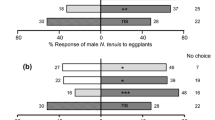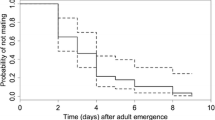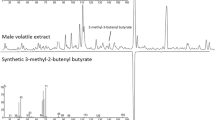Abstract
The pine sawyer Monochamus galloprovincialis Olivier (Coleoptera: Cerambycidae) is a vector of the pine wood nematode Bursaphelenchus xylophilus (Steiner and Buhrer) Nickle. Male and females of this species have a kairomonal attraction to host volatiles and Ips semiochemicals. Once on the host tree, males and females copulate and oviposition occurs. Bioassays using Y-tube olfactometry revealed that females were attracted to volatile compounds produced by males, but not to volatiles produced by females. However, immature males did not seem to release attractants for mature females and immature females did not show any attraction for mature males. A experiment designed to know about mating behaviour in this specie revealed that most of the males encountered females while they were walking. In all pairs both sexes contacted with antennae before copulation, however, in some occasions copulation did not proceed just after antennal contact. On the contrary, in all pairs observed, the male licked the elytra of the female with his mouth palpi just before copulation (licking); immediately afterwards, the male grabbed the female with his forelegs and mounted her suggesting a chemically mediated mate recognition by males.


Similar content being viewed by others
References
Akino T, Fukaya H, Yasui H, Wakamura S (2001) Sexual dimorphism in cuticular hydrocarbons of the white-spotted longicorn beetle, Anoplophora malasica (Coleoptera: Cerambycidae). Entomol Sci 4:271–277
Akutsu K, Kuboki M (1983) Analysis of mating behaviour of udo longicorn beetle, Acalolepta luxuriosa Bates (Coleoptera: Cerambycidae). Jpn J Appl Entomol Z 27:247–251
Allison JD, Borden JH, Mcintosh RL, De Groot P, Gries R (2001) Kairomonal response by four Monochamus species (Coleoptera: Cerambycidae) to bark beetle pheromones. J Chem Ecol 27:633–646
Allison JD, Morewood WD, Borden JH, Hein KE, Wilson IM (2003) Differential bio-activity of Ips and Dendroctonus (Coleoptera: Scolytidae) pheromone components for Monochamus clamator and M. scutellatus (Coleoptera: Cerambycidae). Environ Entomol 32:23–30
Bense A (1995) Longhorn beetles: illustrated key to the Cerambycidae and Vesperidae of Europe. Eikersheim, Margraf Verlag
Crook DJ, Hopper JA, Ramaswamy SB, Higgins RA (2004) Courtship behaviour for the soybean stem borer Dectes texanus texanus (Coleoptera: Cerambycidae): evidence for a female contact sex pheromone. Ann Entomol Soc Am 97:600–604
De Groot P, Nott R (2004) Response of the whitespotted sawyer beetle, Monochamus s. scutellatus, and associated woodborers to pheromones of some Ips and Dendroctonus bark beetles. J Appl Entomol 128:483–487
Evans HF, McNamara DG, Braasch H, Chadoeuf J, Magnusson C (1996) Pest Risk Analysis (PRA) for the territories of the European Union (as PRA area) on Bursaphelenchus xylophilus and its vectors in the genus Monochamus. EPPO Bull 26:199–249
Fauziah B, Hidaka T, Tabata K (1987) The reproductive behavior of Monochamus alternatus Hope (Coleoptera: Cerambycidae). Appl Entomol Zool 3:272–285
Ferreira MC (2000) Insectos vectores do nematodo da madeira do pinheiro. Ed. Plátano Edições Técnicas, Lda. Lisboa, Portugal
Fukaya M (2003) Recent advances in sex pheromone studies on the white-spotted longicorn beetle, Anoplophora malasiaca. JARQ, Jpn Agric Res Q 37:83–88
Fukaya M, Honda H (1992) Reproductive biology of the yellow-spotted longicorn beetle, Psacothea hilaris (Pascoe) (Coleoptera: Cerambycidae) I. Male mating behaviors and female sex pheromone. Appl Entomol Zool 27:89–97
Fukaya M, Akino T, Vasuda T, Tatsuki S, Wakamura S (1999) Mating sequence and evidence for synergistic component in female contact sex pheromone of the white-spotted longicorn beetle, Anoplophora malasiaca (Thomson) (Coleoptera: Cerambycidae). Entomol Sci 2:183–187
Fukaya M, Akino T, Vasuda H, Vasui H, Wakamura S (2004) Visual and olfactory cues for mate orientation behaviour in male white-spotted longicorn beetle, Anoplophora malasiaca. Entomol Exp Appl 111:111–115
Fukaya M, Vasui H, Yasuda T, Akino T, Wakamura S (2005) Female orientation to the male in the white-spotted longicorn beetle, Anoplophora malasiaca (Thomson) (Coleoptera: Cerambycidae) by visual and olfactory cues. Appl Entomol Zool 40:63–68
Ginzel M, Hanks L (2003) Contact pheromones as mate recognition cues of four species of longhorned beetle (Coleoptera: Cerambycidae). J Insect Behav 16:181–187
Ginzel M, Blomquist G, Millar J, Hanks L (2003) Role of contact pheromones in mate recognition in Xylotrechus colonus. J Chem Ecol 29:533–545
Hall DR, Cork A, Phythian SJ, Chittamuru S, Jayarama BK, Venkatesha MG, Sreedharan K, Seetharama HG, Vinod Kumar PK, Naidu R (2006) Identification of components of male-produced pheromone of coffee white stemborer, Xylotrechus quadripes Chevrolat (Coleoptera: Cerambycidae). J Chem Ecol 32:213–237
Hanks LM (1999) Influence of the larval host plant on reproductive strategies of cerambycid beetles. Annu Rev Entomol 44:483–505
Hanks LM, Millar JG, Paine TD (1996) Mating behaviour of the Eucalyptus longhorned borer (Coleoptera: Cerambycidae) and the adaptive significance of long “horns”. J Insect Behav 9:383–393
Ibeas F, Gallego D, Diéz JJ, Pajares JA (2007) An operative kairomonal lure for managing pine sawyer beetle Monochamus galloprovincialis (Coleoptera: Cerambycidae). J Appl Entomol 131:13–20
Iwabuchi K (1982) Mating behavior of Xylotrechus pyrrhoderus Bates (Coleoptera: Cerambycidae) I. Behavioral sequences and existence of the male sex pheromone. Appl Entomol Zool 17:494–500
Iwabuchi K (1988) Mating behavior of Xylotrechus pyrrhoderus Bates (Coleoptera: Cerambycidae). VI. Mating system. J Ethol 6:69–76
Iwabuchi K (1999) Sex pheromones in Cerambycidae. In: Hidaka T, Matsumoto T (eds) Environmental entomology-behavior, physiology and chemical ecology. University of Tokyo Press, Tokyo, pp 436–451
Kim GH, Takabayashi J, Takahashi S, Tabata K (1992) Function of pheromones in mating behavior of the Japanese pine sawyer beetle, Monochamus alternatus Hope. Appl Entomol Zool 27:489–497
Kim GH, Takabayashi J, Takahashi S, Tabata K (1993) Function of contact pheromone in the mating behaviour of the Cryptomeria bark borer, Semanotus japonicus Lacordaire (Coleoptera: Cerambycidae). Appl Entomol Zool 28:525–535
Kuboki M, Akutsu K, Sakai A, Chuman T (1985) Bioassay of the sex pheromone of the udo longicorn beetle, Acalolepta luxuriosa Bates (Coleoptera: Cerambycidae). Appl Entomol Zool 20:88–89
Lacey ES, Ginzel MD, Millar JG, Hanks LM (2004) Male-Produced aggregation pheromone of the cerambycid beetle Neoclytus acuminatus acuminatus. J Chem Ecol 30:1493–1507
Liendo C, Morillo F, Sánchez P, Muñoz W (2005) Olfactory behavior and electroantennographic responses of the cocoa beetle, Steirastoma breve (Coleoptera: Cerambycidae). Fla Entomol 88:117–122
Miller DR, Asaro C (2005) Ipsenol and Ipsdienol attract Monochamus titillator (Coleoptera: Cerambycidae) and associated large pine woodborers in Southeastern United States. J Eco Entomol 98:2033–2040
Mota MM, Braasch H, Bravo MA, Penas AC, Burgermeiter W, Metge K, Sousa E (1999) First report of Bursaphelenchus xylophilus in Portugal and in Europe. Nematology 1:727–734
Pajares JA, Ibeas F, Díez JJ, Gallego D (2004) Attractive responses by Monochamus galloprovincialis (Col., Cerambycidae) to host and bark beetle semiochemicals. J Appl Entomol 128:633–638
Sousa E, Bravo MA, Pires J, Naves P, Penas AC, Bonifacio L, Mota MM (2001) Bursaphelenchus xylophilus (Nematodo: Aphelenchoididae) associated with Monochamus galloprovincialis (Coleoptera: Cerambycidae) in Portugal. Nematology 3:89–91
Vives E (2000) Coleoptera, Cerambycidae. In: Ramos E (ed) Fauna Iberica, vol 12. Museo Nacional de Ciencias Naturales, CSIC, Madrid p 716
Wang Q (1998) Evidence for a contact female sex pheromone in Anoplophora chinensis (Forster) (Coleoptera: Cerambycidae: Lamiinae). Coleopt Bull 52:363–368
Wang Q, Li IS, Zeng WY, Yin XM (1991) Sex recognition by males and evidence for a female sex pheromone in Paraglenea fortunei (Coleoptera: Cerambycidae). Ann Entomol Soc Am 84:107–110
Zhang A, Oliver IE, Aldrich IR, Wang B, Mastro VC (2002) Stimulatory beetle volatiles for the Asian longhorned beetle, Anoplophora glabripennis (Motschulsky). Z Naturforsch C 57:553–558
Zhang A, Oliver IE, Chauhan K, Zhao B, Xia L, Xu Z (2003) Evidence for contact sex recognition pheromone of the Asian longhorned beetle, Anoplophora glabripennis (Coleoptera: Cerambycidae). Naturwissenschaften 90:410–413
Acknowledgments
We thank people from Laboratorio de Sanidad Forestal (Junta de Castilla y León), Jose Manuel Heras (Castile and Leon Forest Service) for assistance in obtaining wild insects, Gerardo Sánchez (DGB, Madrid) for providing technical support. Dr. David R. Hall (Natural Resources Institute, University of Greenwich) reviewed the manuscript and made valuable comments. Financial support was provided by Dirección General para la Biodiversidad, Ministerio de Medio Ambiente, Madrid, (Spain).
Author information
Authors and Affiliations
Corresponding author
Rights and permissions
About this article
Cite this article
Ibeas, F., Díez, J.J. & Pajares, J.A. Olfactory Sex Attraction and Mating Behaviour in the Pine Sawyer Monochamus galloprovincialis (Coleoptera: Cerambycidae). J Insect Behav 21, 101–110 (2008). https://doi.org/10.1007/s10905-007-9104-1
Revised:
Accepted:
Published:
Issue Date:
DOI: https://doi.org/10.1007/s10905-007-9104-1




